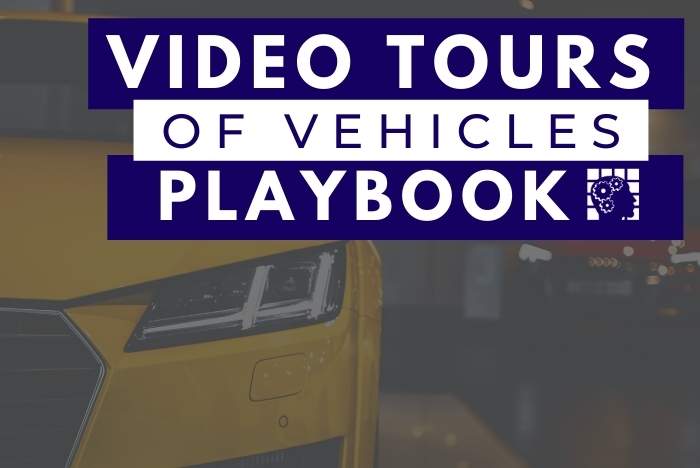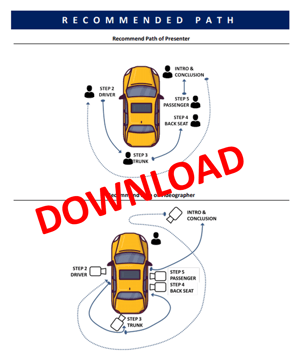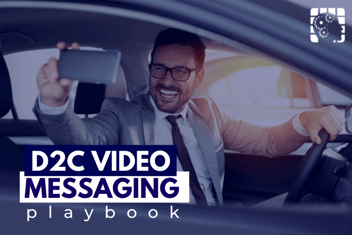Playbook for Vehicle Video Tours


Sending customers a video tour of the vehicle that they are interested in is a great tool to have in your toolkit. It does not need to be complicated, nor do you need fancy equipment. A video tour that is (or at least seems) personalized is a great way to build trust through exceptional service. With some practice and a consistent plan you will see a very high ROI from these videos, translating to both a well-served, happy customer and more money in your wallet.
If you want to get started, look no further than this Playbook for Vehicle Video Tours.
Quick Links
Example of Effective Video Tour
Example of an Ineffective Video Tour
Best Practices
Length
The sweet spot for a video tour is 3 to 5 minutes. A video in this time frame sparks curiosity and provides the key information without demanding too much time.
Personalization (Maybe?)
Generally, the best approach is to personalize your message by including your customer's name and integrating their specific questions and concerns into the video. However, consider the circumstances before personalizing the video. How far along is the customer in their buying journey? Is there a benefit to being able to re-use the same video for multiple customers? The more personal the message, the harder it is to re-purpose the video for another customer. If the situation calls for it, you can make it seem personal while retaining the flexibility to use the video with other clients.
| Personalized | Flexible |
| "Hi, [customer's name], this is [sales rep's name] from [dealership] here. We spoke [on the phone] [this morning] about this [vehicle] . . ." | "Hi, [sales rep's name] from [dealership] here. We spoke earlier about this [vehicle] . . . " |
The best approach depends on the situation, but when in doubt, err on the side of personalizing the video.
Getting Started
- Technology - If you or your store have quality video equipment, use it. However, if high quality equipment is not available, or you do not know how to operate it, a cell phone made in 2018 or later will work perfectly fine.
- People - If possible, there should be one person filming and one person speaking to the camera. If necessary, the same person can do both at the same time, but that should be a last resort as it negatively impacts the overall quality of the video.
- Sending to Customer - The simplest method is to text the video to your customer. However, the quality of the video will degrade and provides limited flexibility for customers who would prefer to watch the video on another device. The preferred (yet still simple) method is post the video on YouTube. It can be a public or private link, depending on your preferences. Then you can send that link to the customer.
- Editing - Editing your video is a must, but it doesn't have to be complicated or Hollywood-level quality. Most computers and phones have pre-installed and free video editors that will more than suffice. At the very least, you need to ensure that the beginning and the end of the video are cleanly clipped to the appropriate length. Another simple option is to make a very basic introduction video using your the video editor on your computer that simply has the name and logo of your dealership.
Flow of the Video
For example, before you begin the video, you should have an idea of which areas of the vehicle you'll show, what order you will show them in, and what items and features you'll discuss along the way. This will help your video look and sound more professional rather than like a home video.
Filming the Video
- Focus on the Vehicle - The vehicle is the star of the show. Focus on the vehicle rather than the person presenting. There are going to be times where it makes sense for the presenter to be in the shot, such as the intro/conclusion and maybe to point to particular features of the vehicle, but never let the presenter detract from making the vehicle the centerpiece
- Slow and Steady - One of the biggest mistakes people make is moving too quickly and shaky.
- Always use both hands to hold the camera
- Hold the camera close to your body to increase stability
- Walk very slowly and with as little bounce in your step as possible. Pretend like you're carrying a bowl of water and you don't want any of it to spill out.
- No sudden movements. Move the camera at a consistent, slow speed. For example, it should take 3-5 seconds to pan from the steering wheel to the console.
- Positioning - Pull the vehicle into a location that will serve as a nice back-drop. Make sure there's as little background motion as possible, including cars driving down a nearby road or other employees walking in the background.
- Horizontal - If using your phone, hold it horizontally, not vertically. This will enable you to better showcase the vehicle.
- Camera Settings - Even most cell phones will allow you to tweak your video settings. Consider changing the video settings so that you are shooting in 1080p at 60 frames per second. Keep in mind that this will increase the file size of the video.
- Sound - Assuming you don't have a external microphone, the best practice for recording a video with high quality audio is to stay close to the person who is speaking. Test the audio in your intended filming location to make sure it meets your high expectations before shooting an entire video. Make sure you choose a location with as little background noise as possible, including nearby roads, other employees, and other customers.
- Lighting - Proper lighting has a huge impact on smartphone cameras because they have smaller image sensors and lenses. In order to avoid shadows and grainy areas, shoot in consistently well-lit areas. However, be careful not to point your camera at light sources because that will cause overexposed footage.
Tutorial Video
We demonstrate some of the best practices and highlight common challenges in the following video:
Example - What It Should Look Like
This is a good example of an effective video vehicle tour. It's not perfect, but we're not seeking perfection given the purpose and circumstances. It goes into enough detail without dragging on for too long. The camera is relatively smooth, despite being filmed with an iPhone (and nothing else). The tour flows well, and the vehicle is the focus rather than the presenter.
Example - What Not to Do
This video isn't terrible, but it's far from ideal. You'll notice a number of things that went wrong, including:
- Too casual and colloquial.
- Presenter is standing in front of the car and often is in the way, interrupting the customer's ability to see the vehicle.
- Quick and shaky camera movements, especially when showing the inside of the vehicle. Remember, as they say in the military, "slow is smooth, and smooth is fast".
- Poor flow because he didn't plan ahead. He forgot to mention the headlights, so he interrupted the flow of the video to go back to the front of the vehicle. Have a plan in mind and be consistent. It rarely pays off to simply "wing-it".
- The short length (2:05 min) left the customer with more questions than answers. He ignored the passenger side and the trunk. On top of that, he glossed over what's under the hood, which is likely to be a key focus of someone buying this particular vehicle.
- Didn't reiterate his contact information at the end.
How can we help?
Click [HERE] to download our free Video Tour Checklist for free. Contact us at info@appliedconcepts.com to learn more about how we can help your dealership grow sales.




